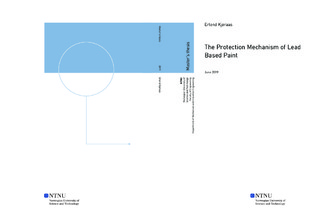| dc.contributor.advisor | Ole Øystein Knudsen | |
| dc.contributor.author | Erlend Kjøraas | |
| dc.date.accessioned | 2019-10-18T14:10:06Z | |
| dc.date.available | 2019-10-18T14:10:06Z | |
| dc.date.issued | 2019 | |
| dc.identifier.uri | http://hdl.handle.net/11250/2623252 | |
| dc.description.abstract | Denne masteroppgaven har til hensikt å belyse blymønjes beskyttende mekanisme mot korrosjon. Det har tidligere vært antatt at tilstedeværelsen av bly på ståloverflaten gir korrosjonsbeskyttelse. Hvilke blykomponenter og mengden vil være viktig for å beskrive de beskyttende egenskapene til jernoksidet.
Fire instrumenter har blitt brukt for å belyse jernoksidets natur. XPS (røntgen fotoelektronspektroskopi), SKP (skanning kelvin probe), TEM (transmisjons elektron mikroskopi) og XRD (røntgen diffraksjon).
Alle karakteriseringsmetodene (XPS, TEM og XRD) viser at bly er til stede. Videre kan følgende konklusjoner dras fra SKP og XPS undersøkelser:
• Inhibisjon av korrosjon kan assosieres med et økt korrosjonspotensial til stål fra -0,44V mot SHE til -0,25V mot SHE.
• Ved dette potensialet vil metallisk bly utfelles på ståloverflaten ved reduksjon av blyioner, ved en antatt konsentrasjon på ca. 10-4M. En alternativ utfellingsmekanisme er konsentrasjonsutfelling av blymonoksid/hydroksid, men mindre sannsynlig.
• Katodisk utfelling av metallisk bly vil føre til at depolarisering av reduksjonsreaksjonen og dermed vil stålet bli anodisk beskyttet.
• Andre mekanismer som en barriere av metallisk bly som hindrer reaksjonene på elektrodene til korrosjonscellen eller en oksid film med høyere motstand mot korrosjon pga. tilstedeværelsen av blyoksider i overflateoksidet. En kombinasjon av alle nevnte mekanismer er tenkelig. | |
| dc.description.abstract | This master thesis aims to reveal the corrosion protective mechanism of lead-based paint (LBP). Previous research indicates that the protective mechanism could be due to presence of lead species on the surface of the steel. Which kind of lead components and in what quantities they exist could be important to describe the true protection mechanism.
Four different instruments has been used for investigation of the surface oxide under the LBP; X-ray photoelectron spectrometry (XPS), scanning kelvin probe (SKP), transmission electron microscope (TEM) and X-ray diffraction (XRD).
Lead is found in all of the characterisation tests (XPS, TEM and XRD). From XPS and SKP, following conclusion can be made:
• Inhibition of corrosion can be associated with a more noble corrosion potential, from the theoretical equilibrium potential of steel at -0.44V vs. SHE to the observed corrosion potential at -0.25V vs. SHE in SKP.
• This potential corresponds to the reduction reaction of lead, at a concentration of approximately 10-4M. Cathodic deposition seems like a possible deposition method of lead. An alternative deposition method could be precipitation deposition of lead monoxide/hydroxide.
• Cathodic deposition will lead to a depolarisation of the reduction reaction, and the steel will be protected due to anodic protection.
• Other mechanism such as a high resistance surface oxide due to the presence of lead oxide or a barrier of metallic lead on the electrodes could be an explanation for the protection. A combination of all three presented protection mechanisms could be a possibility. | |
| dc.language | eng | |
| dc.publisher | NTNU | |
| dc.title | The Protection Mechanism of Lead Based Paint | |
| dc.type | Master thesis | |
